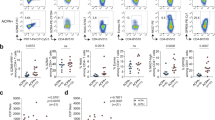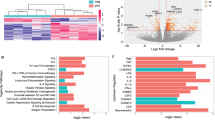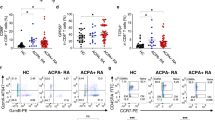Abstract
T-lymphocytes play an important role in rheumatoid arthritis (RA). In this study, we evaluated the hypothesis that common T-cell receptor (TCR) structural features may exist among infiltrating T cells of different RA patients, if the TCR repertoire is shaped by interaction with common self or microbial antigens in the context of susceptible HLA genes in RA. Synovial lesion tissue (ST), synovial fluid (SF) and blood specimens from RA patients and controls were analyzed for TCR V gene repertoire by real-time PCR. There was highly skewed BV14 and BV16 usage in synovial T cells of RA as opposed to those of controls, which was accompanied with a trend for correlation between skewed BV16 and DRB1*0405. Immunoscope analysis of the V–D–J region of ST-derived T cells demonstrated oligoclonal and polyclonal expansion of BV14+ and BV16+ T cells. Detailed characterization using specific BV and BJ primers further revealed common clonotypes combining the same BV14/BV16, BJ and CDR3 length. DNA cloning and sequence analysis of the clonotypes confirmed identical CDR3 sequences and common CDR3 sequence motifs among different RA patients. The findings are important in the understanding of BV gene skewing and CDR3 structural characteristics among synovial infiltrating T cells of RA.
This is a preview of subscription content, access via your institution
Access options
Subscribe to this journal
Receive 6 digital issues and online access to articles
$119.00 per year
only $19.83 per issue
Buy this article
- Purchase on Springer Link
- Instant access to full article PDF
Prices may be subject to local taxes which are calculated during checkout








Similar content being viewed by others
References
Lee DM, Weinblatt ME . Rheumatoid arthritis. Lancet 2001; 358: 903–911.
Lipsky PE, Davis LS . The central involvement of T cells in rheumatoid arthritis. Immunologist 1998; 6: 121–129.
Kerlan-Candon S, Combe B, Vincent R, Clot J, Pinet V, Eliaou JF . HLA-DRB1 gene transcripts in rheumatoid arthritis. Clin Exp Immunol 2001; 124: 142–149.
MacGregor A, Ollier W, Thomson W, Jawaheer D, Silman A . HLA-DRB1*0401/0404 genotype and rheumatoid arthritis: increased association in men, young age at onset, and disease severity. J Rheumatol 1995; 22: 1032–1036.
Fries JF, Wolfe F, Apple R et al. HLA-DRB1 genotype associations in 793 white patients from a rheumatoid arthritis inception cohort: frequency, severity, and treatment bias. Arthritis Rheum 2002; 46: 2320–2329.
Dolhain RJ, van der Heiden AN, ter Haar NT, Breedveld FC, Miltenburg AM . Shift towards T lymphocytes with a T helper 1 cytokine profile in the joints of patients with rheumatoid arthritis. Arthritis Rheum 1996; 12: 1961–1969.
Berner B, Akca D, Jung T, Muller GA, Reuss-Borst MA . Analysis of Th1 and Th2 cytokines expressing CD4+ and CD8+ T cells in rheumatoid arthritis by flow cytometry. J Rheumatol 2000; 27: 1128–1135.
Davis LS, Cush JJ, Schultz-Koops H, Lipsky PE . Rheumatoid synovial CD4+ T cells exhibit a reduced capacity to differentiate into IL-4 poducing T helper-2 effector cells. Arthritis Res 2001; 3: 54–64.
Goronzy JJ, Bartz-Bazzanella P, Hu W, Jendro MC, Walser-Kuntz DR, Weyand CM . Dominant clonotypes in the repertoire of peripheral CD4+ T cells in rheumatoid arthritis. J Clin Invest 1994; 94: 2068–2076.
Struyk L, Kurnick JT, Hawes GE et al. T-cell receptor V-gene usage in synovial fluid lymphocytes of patients with chronic arthritis. Hum Immunol 1993; 37: 237–251.
Gonzalez-Quintial R, Baccala R, Pope RM, Theofilopoulos AN . Identification of clonally expanded T cells in rheumatoid arthritis using a sequence enrichment nuclease assay. J Clin Invest 1996; 97: 1335–1343.
Alam A, Lambert N, Lule H et al. Persistence of dominant T cell clones in synovial tissues during rheumatoid arthritis. J Immunol 1996; 156: 3480–3485.
Londei M, Savill CM, Verhoef A et al. Persistence of collagen type II-specific T-cell clones in the synovial membrane of a patient with rheumatoid arthritis. Proc Natl Acad Sci USA 1989; 86: 636–640.
Pope RM, Pahlavani MA, LaCour E, Sambol S, Desai BV . Antigen specificity of rheumatoid synovial fluid lymphocytes. Arthritis Rheum 1989; 32: 1371–1380.
Devereux D, O'Hehir RE, McGuire J, van Schooten WC, Lamb JR . HLA-DR4Dw4-restricted T cell recognition of self antigen(s) in the rheumatoid synovial compartment. Int Immunol 1991; 3: 635–640.
Res PC, Struijk L, Leow A, Daha MR, van den Elsen PC, Breedveld FC . Inflamed joints of patients with rheumatoid arthritis contain T cells that display in vitro proliferation to antigens present in autologous synovial fluid. Functional analysis on the basis of synovial-fluid-reactive T cell clones and lines. Hum Immunol 1994; 40: 291–298.
Paliard X, West SF, Lafferty JA et al. Evidence for the effects of a superantigen in rheumatoid arthritis. Science 1991; 253: 325–329.
Holoshitz J, Klajman A, Drucker I et al. T lymphocytes of rheumatoid arthritis patients show augmented reactivity to a fraction of mycobacteria cross-reactive with cartilage. Lancet 1986; 2: 305–309.
Zagon G, Tumang JR, Li Y, Friedman SM, Crow MK . Increased frequency of V beta 17-positive T cells in patients with rheumatoid arthritis. Arthritis Rheum 1994; 37: 1431–1440.
Alam A, Lule J, Coppin H et al. T-cell receptor variable region of the beta-chain gene use in peripheral blood and multiple synovial membranes during rheumatoid arthritis. Hum Immunol 1995; 42: 331–339.
VanderBorght A, Geusens P, Vandevyver C, Raus J, Stinissen P . Skewed T-cell receptor variable gene usage in the synovium of early and chronic rheumatoid arthritis patients and persistence of clonally expanded T cells in a chronic patient. Rheumatology 2000; 39: 1189–1201.
Jenkins RN, Nikaein A, Zimmermann A, Meek K, Lipsky PE . T cell receptor V beta gene bias in rheumatoid arthritis. J Clin Invest 1993; 92: 2688–2701.
Williams WV, Fang Q, Demarco D, VonFeldt J, Zurier RB, Weiner DB . Restricted heterogeneity of T cell receptor transcripts in rheumatoid synovium. J Clin Invest 1992; 90: 326–333.
Li Y, Sun GR, Tumang JR, Crow MK, Friedman SM . CDR3 sequence motifs shared by oligoclonal rheumatoid arthritis synovial T cells. Evidence for an antigen-driven response. J Clin Invest 1994; 94: 2525–2531.
Mima T, Ohshima S, Sasi M, Nishioka K, Shimizu M, Murata N . Dominant and shared T cell receptor beta chain variable regions of T cells inducing synovial hyperplasia in rheumatoid arthritis. Biochem Biophys Res Commun 1999; 263: 172–180.
Davey MP, Burgoine GA, Woody CN . TCRB clonotypes are present in CD4+ T cell populations prepared directly from rheumatoid arthritis. Hum Immunol 1997; 55: 11–21.
Even J, Lim A, Puisieux I, Ferradini L, Dietrich PY, Toubert A . T-cell repertoires in healthy and diseased human tissues analysed by T-cell receptor beta-chain CDR3 size determination: evidence for oligoclonal expansions in tumours and inflammatory diseases. Res Immunol 1995; 146: 65–80.
Wagner UG, Koetz K, Weyand CM, Goronzy JJ . Perturbation of the T cell repertoire in rheumatoid arthritis. Proc Natl Acad Sci USA 1998; 95: 14447–14452.
Cohen SE, Bodmer HC . Cytotoxic T lymphocytes recognize and lyse chondrocytes under inflammatory, but not non-inflammatory conditions. Immunology 2003; 109: 8–14.
Moreland LW, Heck Jr LW, Koopman WJ et al. V beta 17 T cell receptor peptide vaccination in rheumatoid arthritis: results of phase I dose escalation study. J Rheumatol 1996; 23: 1353–1362.
Feldmann M, Brennan FM, Maini RN . Role of cytokines in rheumatoid arthritis. Annu Rev Immunol 1996; 14: 397–440.
Hong J, Zang YC, Tejada-Simon MV et al. A common TCR V-D-J sequence in V beta 13.1 T cells recognizing an immunodominant peptide of myelin basic protein in multiple sclerosis. J Immunol 1999; 163: 3530–3538.
Moreland LW, Morgan EE, Adamson III TC et al. T cell receptor peptide vaccination in rheumatoid arthritis: a placebo-controlled trial using a combination of Vbeta3, Vbeta14, and Vbeta17 peptides. Arthritis Rheum 1998; 41: 1919–1929.
Tang J, Myracle AD, Allen S, Karita E, Musonda R, Fultz PN . Novel alleles at the lymphotoxin alpha (LTalpha) locus mark extended HLA haplotypes in native Africans. Hum Immunol 2001; 62: 269–278.
Oksenberg JR, Panzara MA, Begovich A et al. Selection for T-cell receptor V beta-D beta-J beta gene rearrangements with specificity for a myelin basic protein peptide in brain lesions of multiple sclerosis. Nature 1993; 362: 68–70.
Author information
Authors and Affiliations
Corresponding author
Additional information
The work was supported by grants from Chinese Academy of Sciences (Bai-ren Program and Grant KSCX2-SW-212), Chinese National Natural Science Foundation (Grant 30028020) and National Projects 863 (Grant 2002AA216121) and Research Grant 2002CCCD2000 of the Chinese Ministry of Science and Technology and by grants from MAXX Genetech.
Supplementary Information accompanies the paper on Genes and Immunity website (http://www.nature.com/Gene).
Supplementary information
Rights and permissions
About this article
Cite this article
Sun, W., Nie, H., Li, N. et al. Skewed T-cell receptor BV14 and BV16 expression and shared CDR3 sequence and common sequence motifs in synovial T cells of rheumatoid arthritis. Genes Immun 6, 248–261 (2005). https://doi.org/10.1038/sj.gene.6364166
Received:
Revised:
Accepted:
Published:
Issue Date:
DOI: https://doi.org/10.1038/sj.gene.6364166
Keywords
This article is cited by
-
T-cell and B-cell repertoire diversity are selectively skewed in children with idiopathic nephrotic syndrome revealed by high-throughput sequencing
World Journal of Pediatrics (2023)
-
Profiling the repertoire of T-cell receptor beta-chain variable genes in peripheral blood lymphocytes from subjects who have recovered from acute hepatitis B virus infection
Cellular & Molecular Immunology (2014)
-
Dendritic cells and the promise of antigen-specific therapy in rheumatoid arthritis
Arthritis Research & Therapy (2013)
-
Molecular characterization of T cell receptor beta variable in the peripheral blood T cell repertoire in subjects with active tuberculosis or latent tuberculosis infection
BMC Infectious Diseases (2013)
-
Determinants of public T cell responses
Cell Research (2012)



